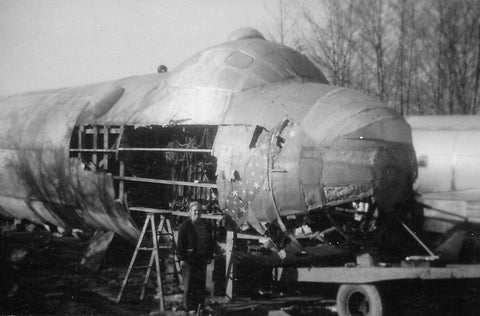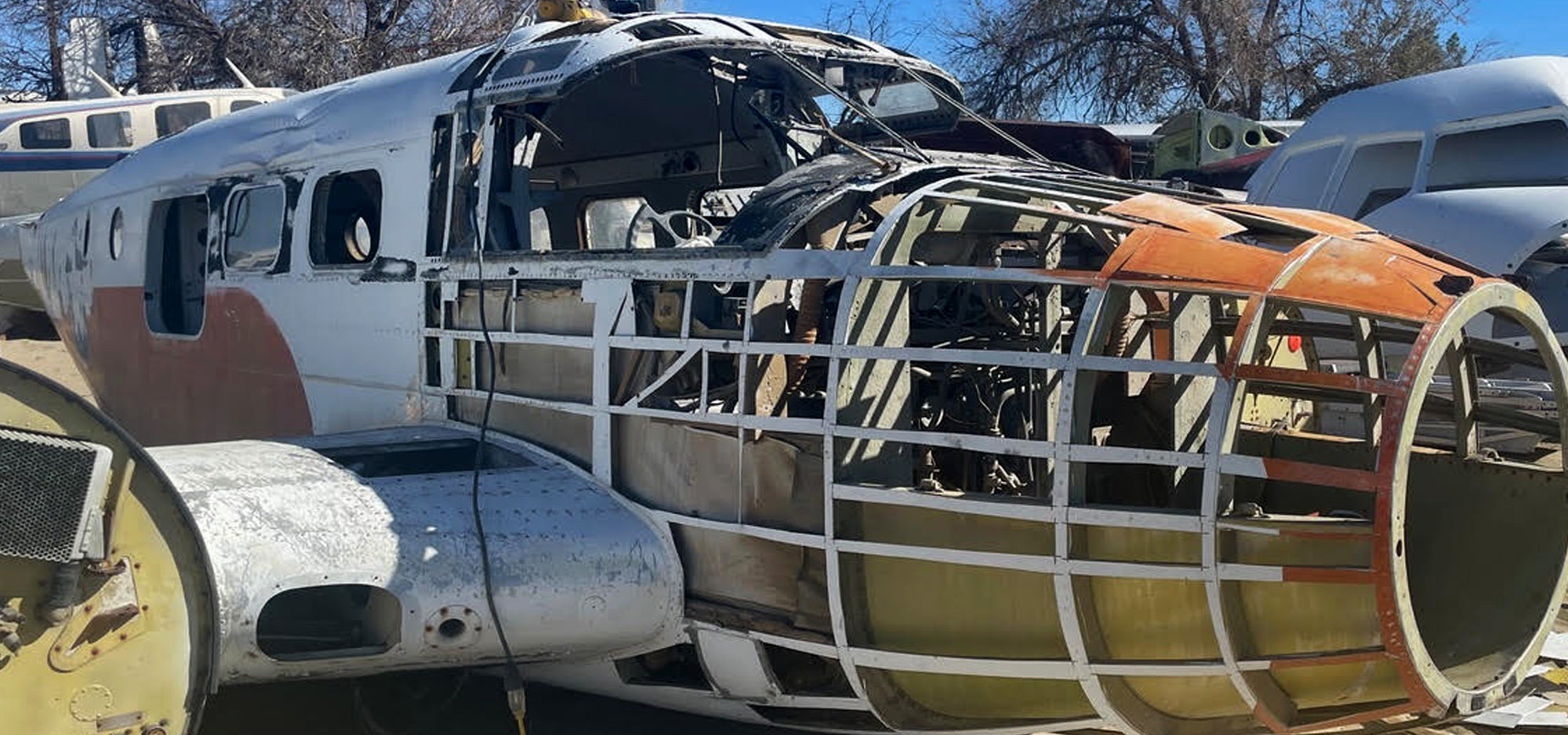The Convair B-36 was conceived in 1941, just as the U.S. was preparing for and entering the second World War. Dubbed “The Peacemaker”, the huge strategic bomber had the longest wingspan of any combat plane built and was the largest mass produced piston-engined plane. Although it was capable of intercontinental flight and delivering nuclear weapons, it was never used in combat. Very few remain today, including one, 42-13571, which was added to the Walter Soplata Collection in August 1972. Read about the legacy of the Peacemaker and the late Walter Soplata, and how MotoArt owner Dave Hall will preserve the memory of both. Want the B-36 Peacemaker for your own collection? Get one here.
B-36 Bomber

YB-36 while sitting outside at the old USAF museum in Dayton, transferred from some old slides, courtesy of Jeff Mills. Used with permission.
In 1941, military minds were seeking a plane that could take off from the United States, fly over to Europe, namely Germany, drop bombs and return home without fueling. The first B-36 prototype, developed by Convair (Consolidated Vultee Aircraft Corporation), was ready within a week of the Japanese surrender in 1945. It flew for the first time on August 8, 1946.
By all accounts, the B-36 fit the original requirements and became, at the time, one of the largest planes to soar through the sky. Its wingspan was a vast 230 feet, with six powerful engines, and propellers which were mounted on the rear of the wing to thrust the aircraft forward. A total of 384 were built.

By U.S. Air Force photo, Public Domain
The B-36 was called the Peacemaker, and the name, in essence, was exactly what it was designed for - a deterrent to aggression. In the post WWII Cold War era, the B-36 suited up to carry a large payload of arms, including nuclear. The hope for this peacemaker was to frighten the enemy into not engaging, but if that was not possible, it still had all the capabilities of making a round trip from the East Coast of the United States to Leningrad to drop its deadly payload. The Peacemaker never fulfilled the bombing portion of its objective.
The scientists of the Manhattan Project had other ideas for the B-36. Not only to deploy nuclear bombs, but also to be nuclear powered itself. The newly fitted NB-36 was large enough to hold the test reactor and support the cockpit modifications made for the safety of the crew. This idea was scrapped in 1958, after a few dozen test flights and many years of design. The B-36 was also entertained as “parasitic fighter” for a short time. This concept involved a fighter plane riding inside the large bomber, which could be released to assist the bomber and later retrieved inside again. Modern airplane designs made both of these ideas obsolete but the idea that the B-36 was large enough and capable of them speaks to the massiveness of this plane.
But, like similar planes such as the B-47 Stratojet and the B-58 Hustler, the Peacemaker had known speed and handling issues that made it vulnerable to being shot down. It was capable of flying across the globe and back without refueling, but it could not be completely counted on to not get shot down. The last B-36 was built in 1954, replaced soon after by the B-52.
USAF B-36 motto: "Six turning and four burning."
B-36 aircrews' unanimous motto: "Two turning, two burning, two joking, two smoking, and two unaccounted for."

YB-36 while sitting outside at the old USAF museum in Dayton, transferred from some old slides, courtesy of Jeff Mills. Used with permission.
B-36 Stats
Span: 230 feet
Length: 162 feet, 1 inches
Height: 46 feet, 9 inches
Weight: 410,000 pounds loaded
Armament: Sixteen M24 20mm cannon in eight nose, tail and fuselage turrets,
86,000 pounds of conventional or nuclear bombs
Engine: Six Pratt & Whitney B 4360s of 3,800 horsepower and
four General Electric J47s of 5,200 pounds thrust each
Maximum speed: 435 mph
Cruising speed: 230 mph
Range: 10,000 miles
Service ceiling: 45,700 feet
Cost: $3,701,000
42-13571

YB-36 while sitting outside at the old USAF museum in Dayton, transferred from some old slides, courtesy of Jeff Mills. Used with permission.
42-13571 rolled out of the Convair aircraft plant in 1944. While WWII raged on, the B-36 was not yet ready to see combat. The prototype plane was originally YB-36 before becoming a YB-36A, then an RB-36E. It was the first B-36 prototype with a bubble canopy, which was later used on production B-36s. While the role of the B-36 in general was being tested throughout the 1940s and 50s, this particular plane was displayed at the original Air Force Museum at Wright-Patterson AFB in Ohio. Once the new National Museum of the USAF opened, a different B-36J was displayed. 42-13571 was cut up and destined for the scrap pile when Soplata bought it and brought it back to his airplane sanctuary in Ohio.
Soplata Collection B-36

Courtesy of Wally Soplata, from the family’s private collection
The handwritten caption for this photo (see below) reads “B36 nose cockpit glass painted over when at AF museum as faded by sun 2x4 wood to fill in missing sections Wife only help”. Mrs. Margaret Soplata was truly an asset to her husband’s airplane sanctuary.

Courtesy of Wally Soplata, from the family’s private collection
“Mom loved all the aviation items too and knew about 90% as much as dad did!” - daughter, Margaret Soplata, from a letter to Dave Hall
Because only 384 B-36s were produced, it is not surprising that only a handful remain. It was with this urgency to preserve the Peacemaker that Walter Soplata sought out one for his collection of planes. It remained there from 1972 until it was purchased by MotoArt’s Dave Hall in 2019.
 Courtesy of Wally Soplata, from the family’s private collection
Courtesy of Wally Soplata, from the family’s private collection
Soplata Collection PlaneTags
The B-36 Peacemaker from the Soplata Collection was a natural fit for a PlaneTag, believes MotoArt owner Dave Hall. “We get asked all the time why we cut up perfectly good airplanes,” said Hall. “We don’t. This plane had been cut up 45 years ago and then stored out in the Ohio elements.” It was in several pieces, the team discovered, some of which had been bolstered with 2x4s to fill in the missing sections. Still, even in pieces and rusted from the dampness, the distinctive silhouette of the B-36 was exciting to see.
“While it may seem like a shame to some to cut up one of the remaining few B-36s out there, it would be more of a shame to let Walter Soplata’s life’s work get lost out here. Especially when there are so many of us who will enjoy having our own piece of this amazing plane and of the incredible story of the Soplata Collection,” said Hall. “This is truly a plane to hang on to and share with the next generation. I imagine it's something akin to what Mr. Soplata himself felt.”

The team began cutting up pieces of the airplane’s skin to transport back to the MotoArt Studio in Torrance, CA. There, each PlaneTag was hand stamped by another craftsman and then hand polished and etched. The finished product is a handsome looking B-36 PlaneTag, ready for gift giving or to add to a collection.

MotoArt would like to thank the Soplata family for sharing stories about their family, for developing these exclusive photos and sharing them with us, and for allowing us to share them as well. To hear about new PlaneTags, special events and sales, and more, visit planetags.com and sign up for our mailing list.
Follow PlaneTags
Follow MotoArt

Courtesy of Wally Soplata, from the family’s private collection





Share:
The Soplata Collection: Preserving Planes for over 70 years
Douglas DC-7: Piston Powered From Coast to Coast